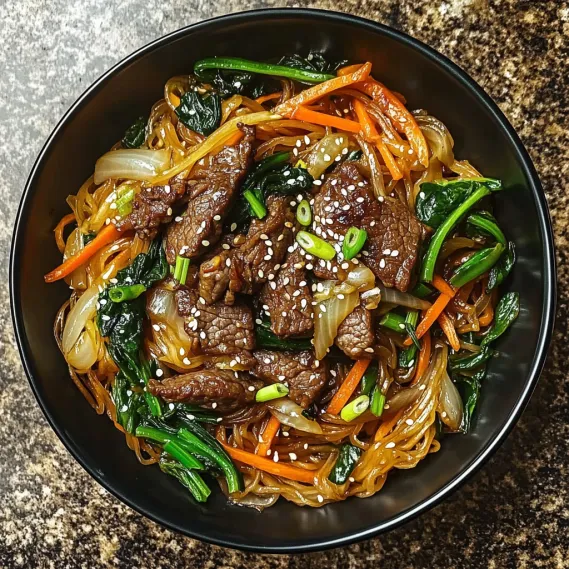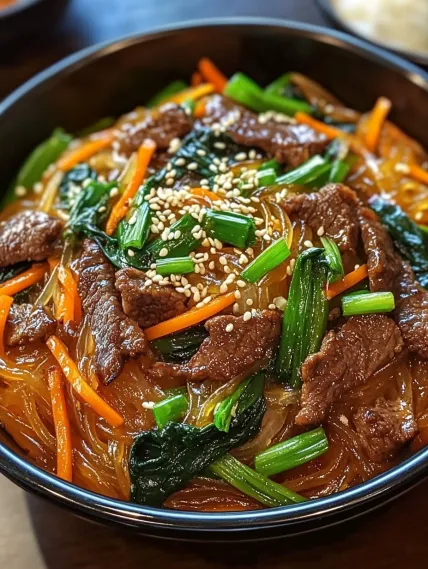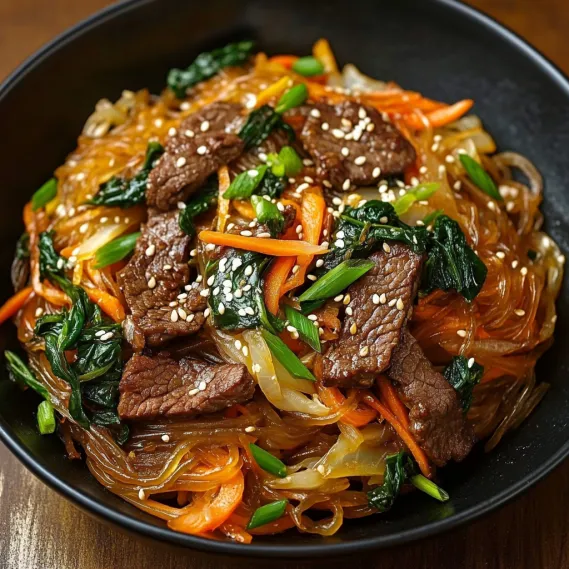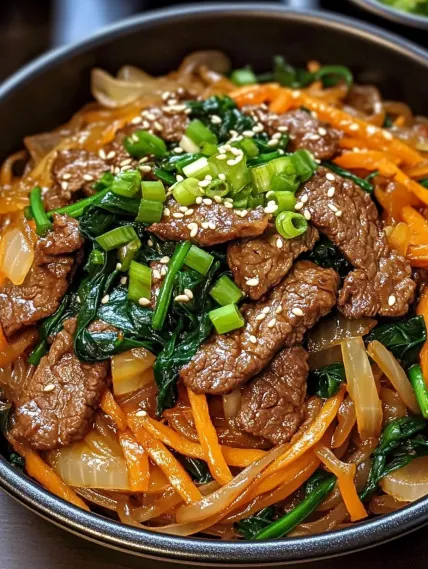 Pin it
Pin it
Sweet potato glass noodles tangle with juicy beef strips and bright veggies in this Korean classic. Japchae delivers a perfect blend of sweet meets savory. The springy noodles contrast wonderfully with crisp veggies and tender meat, all wrapped in a shiny sauce full of toasty sesame and soy flavors. Bright carrots, fresh spinach, and sliced onions don't just make this dish pop visually - they pack in layers of flavor and goodness that'll satisfy both your hunger and your taste for real Korean food.
After coming back from Seoul where I couldn't stop eating this noodle dish, I tried making it myself. My first try was awful - soggy noodles and mushy veggies. It took several attempts and tips from my Korean buddy before I got it right. The key was cooking everything separately then combining at the end. Now when friends come over, this is my showstopper dish. They can't believe how complex it tastes despite using pretty basic stuff.
Key Ingredients and Shopping Guidance
- Sweet Potato Glass Noodles: These clear noodles are what makes this dish special. You'll find them at Asian markets or online shops. Don't swap in rice or wheat noodles - they won't give you that bouncy chew you want.
- Beef: Go for thin slices of ribeye or sirloin. Pop the meat in the freezer for 20 minutes before cutting to get super thin slices that cook quick and stay soft.
- Vegetables: Mix it up with bright carrots, fresh spinach, and sliced onions. Cut everything about the same size so it all cooks evenly and looks pretty.
- Sesame Oil: This fragrant oil brings that nutty taste that makes japchae taste authentic. Get pure sesame oil, not mixed varieties.
- Soy Sauce: Creates the savory base for your sauce. Grab low-sodium if you're watching your salt.
I've noticed splurging on good sesame oil really changes the whole dish. The deep, toasty flavor from quality oil takes everything up a notch and gives you that real Korean taste that makes everyone grab seconds.
Step-by-Step Cooking Guide
- Step 1: Get Those Noodles Ready
- Boil water in a big pot. Toss in the sweet potato noodles and cook them for 5-6 minutes until they're soft but still have some bite. Don't let them get mushy - they should still push back when you bite them. Drain and run cold water over them to stop them cooking.
- Step 2: Make Your Beef Tasty
- Mix your thin beef strips with soy sauce, sesame oil, and brown sugar in a bowl. Let it sit for 10 minutes while you work on other stuff. Get a big skillet or wok really hot and cook the beef until it browns. Put it aside when done.
- Step 3: Cook Your Veggies
- Use the same pan and add some olive oil. Cook each veggie on its own: carrots first until they soften a bit, then onions until see-through, then garlic, and finally spinach just until it wilts. Move each veggie to a plate as it finishes.
- Step 4: Whip Up Your Sauce
- In a small bowl, stir together the rest of your soy sauce, sesame oil, and brown sugar until the sugar melts away. This yummy sauce will coat everything with that perfect japchae flavor that folks can't resist.
- Step 5: Throw It All Together
- Put the noodles back in the pan over medium heat. Pour your sauce all over and toss until the noodles are coated. Add your cooked beef, all the veggies, and green onions, then gently mix it all up until everything's warm.
- Step 6: Final Touch
- Give it a taste and add salt if needed. Everything should taste amazing with tender noodles and flavorful beef.
 Pin it
Pin it
When I made this for my daughter's graduation party, the Korean guests couldn't believe their taste buds. They said it was just like their moms made. My secret? I cooked every veggie on its own to keep the colors bright and textures just right. Then I let everything rest for an hour before serving so all those flavors could really mix and mingle.
 Pin it
Pin it
Amazing Ways to Enjoy Japchae
Japchae isn't just stuck in one lane - it can switch from side dish to main event with a few tweaks. I've found mushrooms work wonders in it, especially shiitakes with their meaty feel and woodsy taste that goes so well with the sweet-savory sauce. In summer, I throw in some thin-cut bell peppers for extra crunch and color. When we have family over with different food needs, I make a big batch of noodles and veggies, then set out protein options on the side - beef, chicken, shrimp, or tofu. Everyone builds their own bowl just how they like it. This DIY approach has made japchae a monthly thing at our house.
Getting Noodles Just Right
Learning how to handle sweet potato noodles took me a few tries before I caught on to their quirks. They're not like regular pasta - they keep soaking up liquid even after cooking, which can turn them into mush if you're not careful. My big breakthrough was cooking them just until they had a little bite, then cooling them fast under cold water. Mixing them with sesame oil stops them sticking and adds flavor from the get-go. Now when I add sauce, I just warm everything through instead of letting it simmer, which keeps the noodles springy not soggy. My husband used to be all about rice dishes, but now he asks for japchae all the time, always mentioning how much he loves the noodle texture.
Making Colors and Flavors Work Together
Korean cooking has this cool idea called 'banchan' that's about balancing flavors, colors, and nutrition. I've taken this to heart with my japchae, making sure each veggie brings something to the table beyond just taste. The deep green spinach, orange carrots, and purple-white onions look gorgeous together and signal all the different nutrients packed in the dish. I've noticed my son, who usually picks around veggies, eats everything in his japchae without complaint - all the flavors work so well together that each bit seems necessary. When I teach cooking at our community center, japchae is my go-to example for showing how careful prep makes food look and taste better.
Food as a Cultural Bridge
Making japchae has grown into more than just cooking a tasty meal - it's opened up Korean culture for our family. After learning this dish was once served in royal courts during the Joseon Dynasty, we got curious about other Korean traditions. Now we celebrate Korean holidays like Chuseok (their harvest festival) with japchae as our main dish. My kids have learned about why the colorful ingredients matter - they stand for harmony and good luck. What started as just trying a new recipe has turned into a real appreciation for the culture, with Korean cookbooks all over our kitchen and Korean TV shows becoming our Friday night thing.
Smart Cooking Tricks
- Get everything cut and ready before you start cooking - things move fast with this stir-fry
- Sprinkle toasted sesame seeds on top just before serving for extra nuttiness and a prettier dish
- When cooking for lots of people, prep all your ingredients ahead and mix them together right before serving
- Want it spicier? Add a spoonful of gochujang (Korean chili paste) to your sauce
- If japchae is your main course, up the meat to 2.5-3 pounds when feeding 10 people
My first time making this, the dish turned out a bit dry. I've since learned that letting everything rest together for a few minutes after cooking makes all the difference in how creamy and delicious it turns out.
Cooking Smart on a Budget
This meal shows how smart cooking can turn affordable ingredients into something fancy. When chicken breasts or steaks go on sale, I grab them to make this dish. I stock up on cube steak when prices drop and freeze portions just for this recipe. Most other ingredients are pantry basics that last ages, so I can whip up restaurant-quality food for way less than takeout.
Making It Work for Everyone
Got picky eaters? This dish is super easy to change up. Kids who turn up their noses at certain veggies often gobble this up because the pasta soaks up all that mushroom goodness. For really fussy eaters, a sprinkle of cheese on top works wonders. You can also sneak in extra veggies like peas or corn for more nutrition. Think of the basic recipe as your starting point - tweak it to make everyone at your table happy.
Switching Up Veggies With the Seasons
One thing I love about this dish is how it changes with the calendar. Summer brings chances to add fresh corn or zucchini. Fall calls for roasted butternut squash or wild mushrooms. Winter versions work great with hearty root veggies. Spring lets you toss in tender asparagus tips and fresh peas. These changes keep the meal exciting all year long while using what's fresh and cheap at your local market.
Shortcuts for Busy Days
For crazy-busy households, this recipe is a lifesaver. You can make the pasta and sauce up to three days ahead and keep them in the fridge. If you need even longer storage, the fully finished dish freezes well for up to three months. When you're ready to eat, just thaw it in the fridge overnight before baking as the recipe says, adding an extra minute or two to the cooking time.
Insider Kitchen Tricks
- Add a bit of dried thyme or rosemary to your mushroom mix for extra flavor punch
- Give the potato chips a quick toast before using them for extra crunch
- Toss in a pinch of cayenne pepper with the mushrooms if you want some heat
- Need thicker sauce? Mix 1 tablespoon cornstarch with 2 tablespoons cold water and stir it in during the last 5 minutes
- This stuff tastes even better the next day - great for leftovers
I found these little tweaks after making this dish many times - especially adding rosemary, which brings amazing depth without being obvious that it's rosemary.
 Pin it
Pin it
This tuna noodle dish has become my reliable standby when I need something that makes everyone happy. The mix of soft pasta, creamy sauce, and crunchy chips creates something that feels like more than just the parts - it's comfort food that seems fancy but comes together so easily.
This tuna noodle bake shows that amazing, satisfying food doesn't need fancy methods or weird ingredients - just good basics put together thoughtfully so they really shine together.
Frequently Asked Questions
- → What exactly are Korean glass noodles, and where can I buy them?
- Glass noodles (dangmyeon) are made from sweet potato starch and have a slightly bouncy, chewy texture. Look for them in Korean markets, Asian stores, or buy them online. They’re labeled as ‘glass noodles’ or ‘sweet potato noodles.’
- → Can I skip the beef to make it vegetarian?
- Sure! Just leave out the meat and add extra veggies like mushrooms, bell peppers, or zucchini. Tofu is also a great protein option. The sesame soy sauce works nicely with just veggies.
- → How do I store leftovers if I make extra?
- Put leftovers in a sealed container in the fridge for 3-4 days. The noodles soak up the sauce a bit, so when warming them up, toss in a little more soy sauce and sesame oil to bring back the flavor.
- → Why do my noodles stick together after cooking?
- They could be overcooked or left out too long. After boiling, rinse them with cold water to cool them off, and mix with a tiny bit of sesame oil to prevent sticking. Add them into the stir-fry right when you’re done cooking.
- → Can I prep this dish ahead of time for a party?
- Totally! It tastes great even at room temperature and can be made a day before. Store covered in the fridge, then bring it to room temperature before serving. Add a little fresh sesame oil before serving to keep it fresh.
